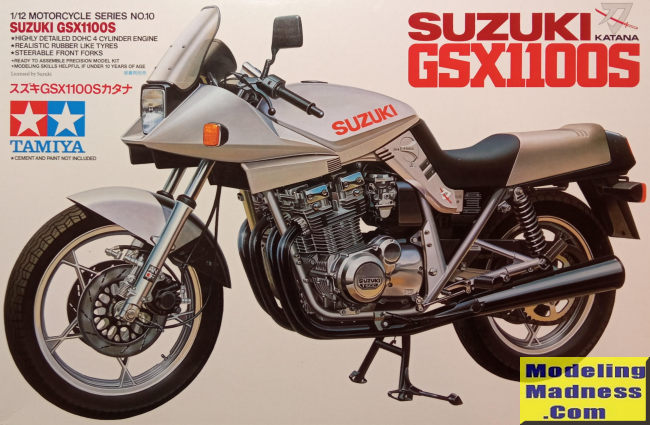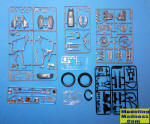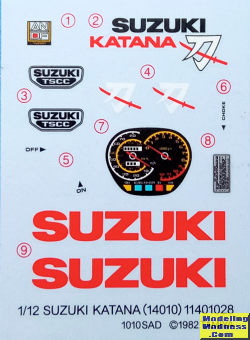
Tamiya 1/12 Suzuki Katana
| KIT #: | 14010 |
| PRICE: | €15 "Special Offer" |
| DECALS: | One Option |
| REVIEWER: | Spiros Pendedekas |
| NOTES: | 1983 release |

| HISTORY |
First appearing in prototype form at the Cologne show in 1979, the GSX1100S made quite an impact with its edgy looks. A brainchild of the talented Hans Muth design wise, the bike was mechanically modern but not to extremity, the frame and power plant being unchanged from the currently in production GSX1100. The engine itself was a transverse four cylinder, DOHC 1100cc unit with 4 valves per cylinder, easily pumping out more than 100hp. Aided by Its innovative frame-mounted aerodynamic fairing and the racing clip-on bars that would place the rider in a more leaning position, the aggressive looking Katana could reach 140mph.
| THE KIT |
 Tamiya first released this kit in 1982, followed by a “custom tuned” version
in 1995, by utilizing some extra parts. To the joy of many of us, Tamiya
recently decided to reissue many of their classic kits at the exact state
that they were first released, with the same decals but freshly printed and
at very interesting prices. To my understanding, these kits are made in the
Philippines but to the exact Tamiya standard and this might also contribute
to the sensible prices these kits are offered.
Tamiya first released this kit in 1982, followed by a “custom tuned” version
in 1995, by utilizing some extra parts. To the joy of many of us, Tamiya
recently decided to reissue many of their classic kits at the exact state
that they were first released, with the same decals but freshly printed and
at very interesting prices. To my understanding, these kits are made in the
Philippines but to the exact Tamiya standard and this might also contribute
to the sensible prices these kits are offered.
Such is the case with this beautiful Katana reissue, being exactly identical
to the 1983 boxing and offered at the very good price of €20 ("reduced" to
€15 after my usual bargain with my friend and owner of my usual Athens hobby
shop…).
Typically for Tamiya, the kit comes in a very attractive, not that big top
opening box of excellent quality, carrying an eye-catching box art of a
Katana in showcase condition. Upon opening the box, the typical Tamiya
excellency continued: I was greeted with three silver gray sprues containing
45 parts, one black containing 30 parts, a nickel plated sprue containing 17
parts, a clear fret, two vinyl tires, vinyl tubing and some mini screws, all
superbly packaged per the Tamiya style.
The styrene parts are very well molded, needing only some scraping-off of
the minimal mold lines (which might otherwise be told apart too much under a
silver or aluminum coat) . Some ejector pin marks are evident, reminiscent
of the 80’s mold origins, but, as far I could see, Tamiya engineers tried to
locate strategically the lot of them at not that prominent places.
The chrome plated sprue is nicely done and contains all parts that are
either chrome plated or polished aluminum or similarly looking on the real
bike. These include, among others, many engine side covers, carburettor
tops, mirrors and light reflectors. The complete front forks and rear
suspension units are also provided as one piece chrome plated parts, meaning
that some of their areas will have to be painted accordingly, in order to
look realistic (such as the fork legs, that have to be painted aluminum and
their brake calipers and seals black).
The engine is well detailed, the parts comprising it being molded in such a
way that few seams will be visible once assembled. The frame, another
prominent feature of the Katana, is provided in two parts (left and right),
also looking sufficiently detailed, but with a few slight sink marks
present (located at hard to notice areas, speaking the truth).
The 4-to-2 exhaust is supplied in 7 parts and, although looking correct in
shape, will seemingly need some filing and sanding job to look homogenous
once assembled. The distinctive wheel rims look convincing, as does the rear
swing arm. The disk brakes’ outer areas are nice, but their inner areas not
only are plain flat, but also have a couple of ejector marks (hopefully they
will not be that visible). The chain is supplied as one piece with its guard
and looks good.
The front fairing, fuel tank, the side covers and rear cowl look very
convincing, as also do the handlebars, the center and side stands and the
saddle itself. Instruments are represented with a nice decal. The tires are
typically rubber-made and look realistic, with brand logos molded on them.
The clear fret caters for all transparent parts that are found on the real
bike, such as the front screen, the light lenses and so on. All clear parts
are excellently molded and crystal clear. A generous length of vinyl tubing
is also provided, to cater for the various cables and hoses. Finally, 25
mini screws are supplied, in order to secure most subassemblies to the frame
(somehow like in the real bike).
Instructions are provided as a b/w pamphlet and are done in the typically
excellent Tamiya style, containing a concise history of the bike, a parts
list, with the construction itself spread in 14 clear and followable steps.
Color callouts are given during assembly, with many pics of completed
sections also provided as a very useful aid.
 The paint scheme is the classic allover gloss aluminum with the front seat
and rear cowl done at a particular shade of intermediate blue (leaning
towards teal): very attractive indeed! Decals are freshly printed and look
superb.
The paint scheme is the classic allover gloss aluminum with the front seat
and rear cowl done at a particular shade of intermediate blue (leaning
towards teal): very attractive indeed! Decals are freshly printed and look
superb.
Instructions want you to first assemble the engine, air cleaner and rear
fender, then trap them between the frame halves. The exhausts are next
assembled and attached. The rear wheel, rear brake and chain are
subsequently to be trapped between the swing arm halves, the complete
sub-assembly then to be attached to the frame, together with the rear
suspension units and the center stand.
The three piece fuel tank is afterwards assembled and attached, together
with the side covers, rear cowl, rear flash indicators, driver’s foot pegs
and rear brake lever. The fairing assembly and installation is next,
followed by assembly of the handlebars.
Building up of the front section follows and it is accomplished by trapping
the front wheel and its fender between the front forks, with the complete
sub-assembly attached onto the main model, followed by the handlebars, the
front screen, the turn indicators and, finally, the mirrors, ending a
definitely not uncomplex but seemingly not complicated build, as every step
looks clear and concise, a-la Tamiya style.
| CONCLUSIONS |
Despite its age, this looks to be a very good kit of the iconic Katana, as
it is well molded, offers plenty of details and is said to have good fit. To
their credit, Tamiya not only decided to reissue the kit after so many
years, but also to offer it at a really good price.If you fancy building an
iconic 80s superbike, let alone the Katana itself, this is a kit worth
tackling!
Happy modeling!
Spiros Pendedekas
Copyright ModelingMadness.com. All rights reserved. No reproduction in part or in whole without express permission from the editor.
If you would like your product reviewed fairly and fairly quickly, please contact the editor or see other details in the Note to Contributors.